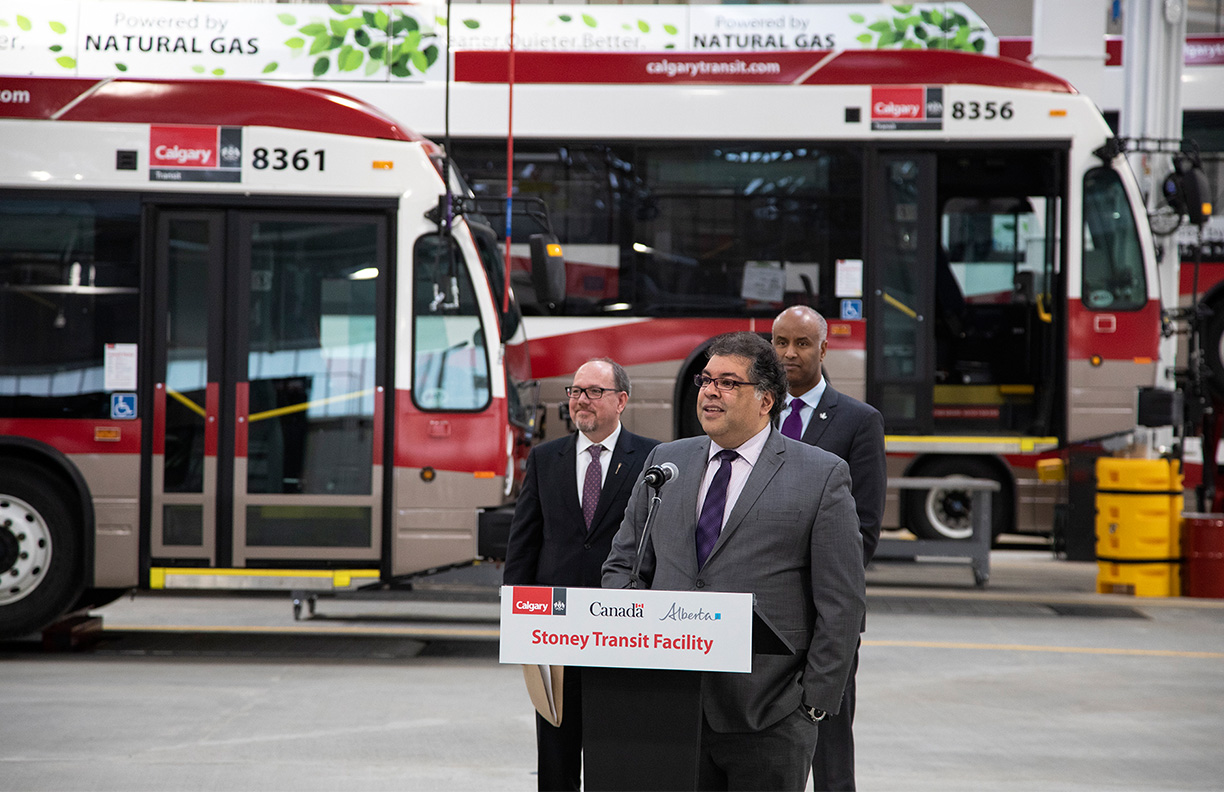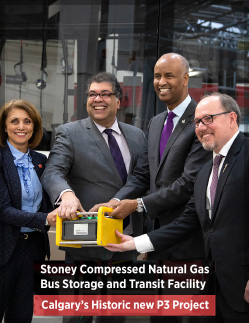Calgary’s Historic New P3 Project
By Anna Guy
It was an important day for not only Calgary, but all of Canada: on March 12, 2019, North America’s largest indoor Compressed Natural Gas (CNG) bus facility officially opened. The City of Calgary’s Stoney Compressed Natural Gas Bus Storage and Transit Facility—a $174 million, 44,300-square-metre facility (the equivalent of 27 NHL rinks) will provide storage and maintenance space for 470 of Calgary’s city buses, with detail cleaning bays, and, most notably, and on-site CNG gas fuelling infrastructure.
“Our government has a strong record of investing in a sustainable transportation network for Calgary, supporting both vehicle and public infrastructure,” said the Honourable Brian Mason, Minister of Alberta Transportation, at the opening. “This facility means more Calgarians will benefit from efficient, safe and environmentally friendly public transit, spending less time in traffic and easily getting to where they need to go.”
It’s an investment into more than just transit. By focusing on CNG, the Stoney Transit Facility is an investment in the environment as CNG buses produce far lower tail pipe emissions. CNG is a clean-burning fuel and, although it does produce greenhouse gases, it is less than gas or diesel. Located in the Stoney industrial area in north-central Calgary, the facility will initially provide diesel bus operations as the city transitions CNG buses into its fleet.
“The Stoney Transit Facility demonstrates Calgary’s commitment to transit, the environment, and cost reduction,” says Danny Panday, Senior Project Manager, Transportation Infrastructure. “This facility is designed and built to accommodate the growth we expect to see over next 30 years, which will take transit close to 1,500 buses.”
The Stoney Transit Facility means significant financial savings for the city as well. CNG will mean a savings in excess of $10,000 per year per bus, or around $4 million in fuel costs when fully operational. “Beyond just the reduction in fuel costs, there will be lower maintenance costs compared to other fossil-fuel powered vehicles, and quieter running engines,” says Panday. Calgarians will also benefit from permanent jobs created with the operation and maintenance of this bus storage and transit facility.
“I’m so pleased that our fleet of CNG buses are now part of our Calgary Transit fleet,” says Mayor Naheed Nenshi. “Investments in transit are among the best investments any city can make—they are investments in the environment, reducing congestion and improving mobility.”
P3
The Stoney Bus Facility is an example of why Canada is a global leader in P3 projects. The City of Calgary chose a P3 as an affordable, high value/low risk investment. With additional funding from the Federal Government, the Province of Alberta, and the City’s partner, Plenary Infrastructure Calgary LP, the Stoney Bus Facility is one of the largest of its kind in the world. In keeping with the goal of energy and environmental stewardship, the facility is to be certified LEED Gold, and is efficient in energy consumption and provides a safe and healthy work environment for staff that use the facility.
Dan Wurst, Vice President of Plenary Group, says his company is “thrilled” to be delivering this historic project, and looks forward to a long-term partnership with the City of Calgary.
“Investing in public transit infrastructure is essential to ensuring people can spend less time in traffic commuting home from work and more precious time with their families,” said the Honourable Ahmed Hussen, Minister of Immigration, Refugees and Citizenship (who spoke on behalf of the Minister of Infrastructure and Communities). “The new Stoney Transit Facility will help meet growing demand, support better daily transit services and protect the environment by supporting cleaner energy systems.”
“We are proud that Calgary is making forward-thinking decisions around transit and infrastructure development,” says Panday. There is no question the Stoney Transit Facility will provide long-term value for Calgary, and will serve as a template for cost efficient, environmentally-responsible municipal thinking. Already garnering the attention of other North American cities whose transit systems are nearing their end of service, and thus considering alternatives to diesel-fuelled buses, the impact of this facility extends beyond Calgary’s borders.







 Click to view Brochure
Click to view Brochure